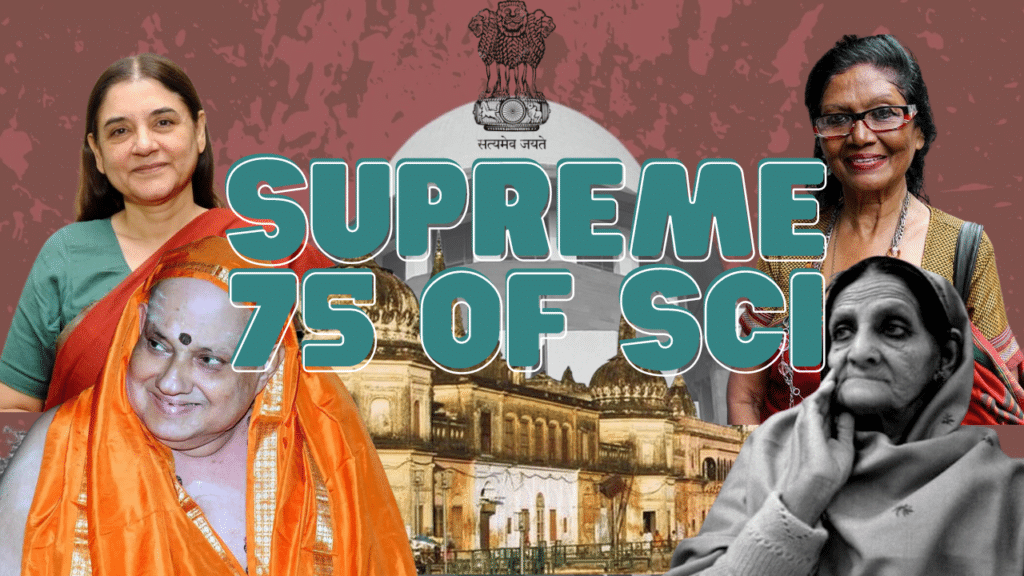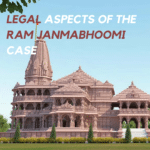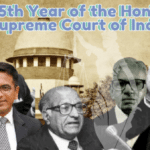
Authored by – Kanika Arora
75 Years of the Supreme Court of India
Introduction:
As the Supreme Court marks its 75th year, this article takes a nostalgic yet critical look at its profound influence on the Indian legal system. From its inception to the present day, the Supreme Court has been a guardian of justice, rendering judgments that have not only interpreted the law but have often set new legal precedents.
On January 28, 1950, a nascent India took a momentous step towards solidifying its democratic foundations. The Supreme Court of India, established on that historic day, has since become the guardian of the Constitution, upholding the rule of law and protecting the rights of over 1.3 billion citizens. As India embarks on its 75th year of independence, reflecting on the Supreme Court’s legacy offers valuable insights into the nation’s evolution and underscores the crucial role of an independent judiciary in a vibrant democracy.
- Pillars of Justice: Landmark Judgments that Shaped India:
The Supreme Court’s history is etched with landmark judgments that have redefined the legal landscape and social fabric of India. From guaranteeing the right to equality in Maneka Gandhi v. Union of India (1978) to decriminalizing homosexuality in Navtej Singh Johar v. Union of India (2017), the court has consistently pushed the boundaries of social progress and human rights. Its rulings on environmental protection, freedom of speech, and access to education have not only empowered individuals but also laid the foundation for a more just and equitable society.
- Beyond Rulings: Addressing Contemporary Challenges:
Despite its undeniable contributions, the Supreme Court faces contemporary challenges threatening its effectiveness and accessibility. Concerns regarding the pendency of cases, judicial appointments, and the impact of executive overreach highlight the need for continuous introspection and reform. The increasing burden on the court necessitates efficient disposal of cases while ensuring due process and thorough adjudication. Additionally, ensuring greater diversity and inclusivity within the judiciary is crucial to uphold public trust and reflect the changing demographics of India.
- Guiding Light for the Future: Upholding the Rule of Law and Envisioning a Just India:
As India navigates the complexities of the 21st century, the Supreme Court’s role in upholding the rule of law and securing the fundamental rights of its citizens remains paramount. Protecting judicial independence, fostering access to justice for marginalized communities, and adapting to the evolving demands of a digital age are some pressing issues that necessitate continuous dialogue and reform. By embracing innovation, public engagement, and a commitment to social justice, the Supreme Court can continue to be a beacon of hope, guiding India toward a future where the fundamental rights and aspirations of all citizens are truly realized.
Landmark Cases of the Indian Supreme Court in its 75-Year Journey:
As India celebrates the 75th anniversary of its independence, let’s revisit some of the landmark judgments delivered by the Supreme Court that have shaped the nation’s legal and social landscape:
- Kesavananda Bharati v. State of Kerala (1973): This case established the “basic structure doctrine,” outlining that the Constitution’s core principles cannot be altered by amendments. It ensured constitutional stability and protected fundamental rights from legislative overreach.
- Shah Bano Begum v. Mohd. Danial Latifi (1985): This case upheld the right of a Muslim woman to alimony after divorce, challenging the discriminatory application of personal laws. It sparked debate on gender equality and religious jurisprudence.
- Minerva Mills v. Union of India (1980): This case struck down two amendments that sought to curtail judicial review, reaffirming the court’s power to uphold the Constitution’s basic structure. It cemented the principle of judicial checks and balances.
- Olga Tellis v. Bombay Municipal Corporation (1985): This case recognized the right to life with dignity, including access to necessities like housing. It paved the way for judicial intervention in slum rehabilitation and poverty alleviation.
- Maneka Gandhi v. Union of India (1978): This case broadened the scope of Article 21 (right to life) to include personal liberty and freedom of movement. It empowered individuals to challenge arbitrary state actions impacting their fundamental rights.
- T.M.A. Pai Foundation v. State of Karnataka (2002): This case upheld the right to manage educational institutions based on their fundamental character, paving the way for private institutions with limited state interference. It sparked ongoing debates about autonomy and accountability in education.
- Navtej Singh Johar v. Union of India (2017): This case decriminalized consensual sexual activity between same-sex adults, recognizing LGBTQ+ rights and promoting inclusivity. It marked a significant milestone in the fight for equality and non-discrimination.
- Aadhaar Judgment (2017): This case upheld the constitutional validity of the Aadhaar scheme, recognizing its potential for financial inclusion and welfare delivery. However, it also addressed concerns about privacy and data protection, creating a framework for balancing technology with individual rights.
- Sabarimala Review Petitions (2018): This case overturned a previous ban on women of menstruating age entering the Sabarimala temple, upholding the principle of gender equality in places of worship. It ignited passionate debates about religious practices and individual rights.
- Ayodhya Ram Janmabhoomi-Babri Masjid Title Dispute Case (2019): This landmark verdict brought closure to a long-standing religious dispute, awarding the disputed land in Ayodhya for the construction of a Ram temple, while directing the government to provide alternate land for a mosque. It highlighted the complexities of religious conflict resolution and the court’s role in mediating sensitive societal issues
These are just a few examples of the Supreme Court’s impactful judgments, showcasing its diverse and evolving role in shaping Indian society. As the nation progresses, the court’s future decisions will undoubtedly continue to influence the legal landscape and address emerging challenges, contributing to India’s journey toward a more just and equitable future.
Conclusion:
The 75 years of the Supreme Court encapsulate a legacy of legal wisdom, resilience, and evolution. This article celebrates the milestones, acknowledges the challenges, and underscores the pivotal role the Supreme Court has played in shaping India’s legal identity. As the court continues its journey, it is essential to reflect on its rich history and appreciate the dynamic interplay between legal principles and societal transformation.
The 75th anniversary of the Supreme Court of India is a moment to celebrate not just the institution’s remarkable legacy but also its unwavering commitment to shaping a fairer and more equitable India. Its journey, though marked by challenges, is a testament to the enduring power of an independent judiciary in safeguarding the very essence of democracy.
As India stands on the threshold of a new era, the Supreme Court’s responsibility to uphold the rule of law, protect individual rights, and navigate the complexities of the future remains its defining mission. By staying true to its ideals and constantly striving for improvement, the court can continue to serve as a symbol of hope, ensuring that the promises of equality, justice, and liberty enshrined in the Indian Constitution remain a living reality for every citizen.





